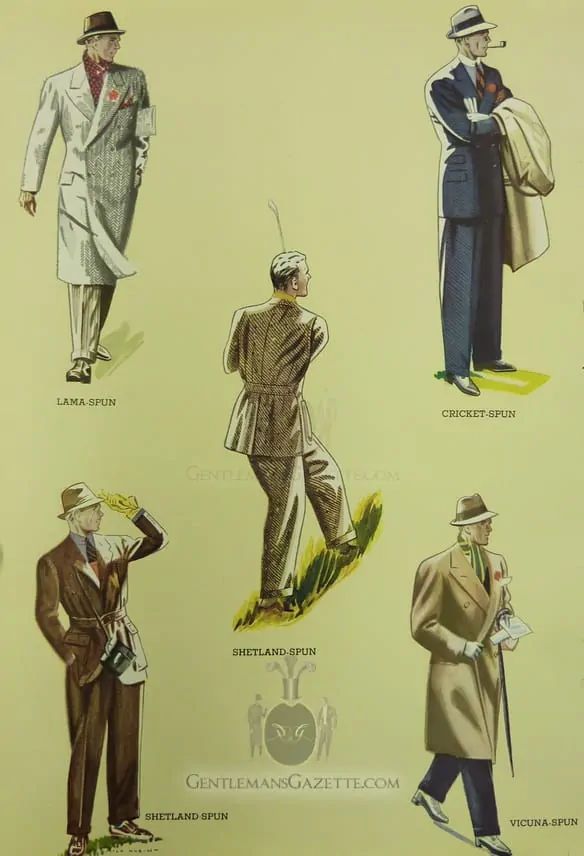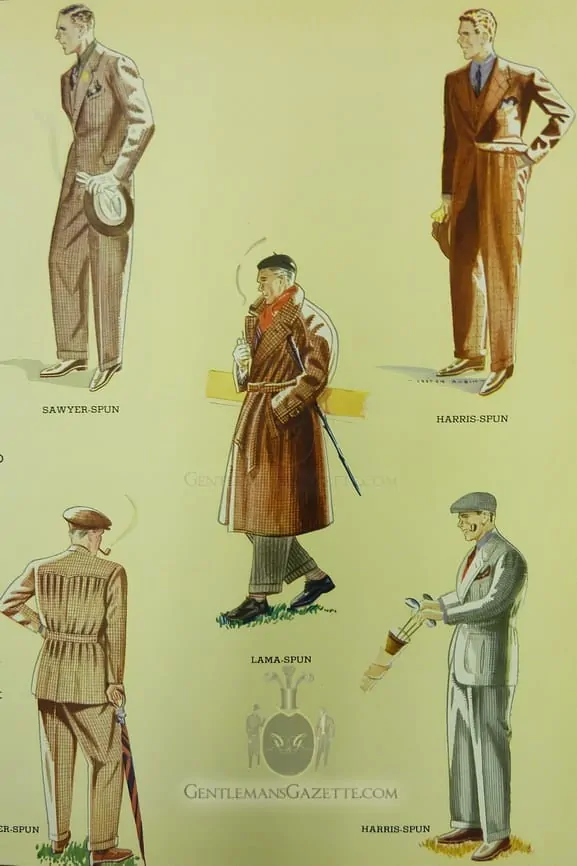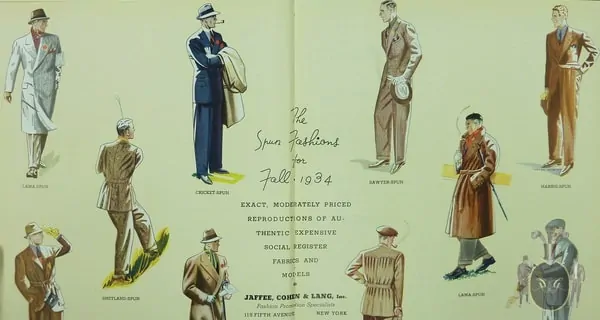Sometimes, it seems as if the figures in the Apparel Arts fashion illustrations are too well dressed. Often, the proportions of these tall men are simply out of this world – distorted by the ideal perceptions of the time. And so, it helps to look at ads, catalogues, and vintage photographs in order to understand what was really sold and worn by the man on the street.
Interestingly, Apparel Arts issues from the 1930’s rarely had photographs of people in them, whereas the German Herrenjournal had many, which we will look at more closely in the future.
Today, we want to take a look at an interesting ad from 1934, illustrated by Lester Rubin, who created numerous fashion illustrations for Apparel Arts. Titled “The Spun Fashions for Fall 1934,” the fashion promotion specialist, JAFFEE, COHEN & LANG, Inc. from 115 Fifth Ave, New York promises ”EXACT, MODERATELY PRICED REPRODUCTIONS OF AUTHENTIC EXPENSIVE SOCIAL REGISTER FABRICS AND MODELS.” This ad clearly indicated that the things we usually see were, in fact, the flagship models and styles of each brand, but not necessarily what most men would wear.
Fall Outfits 1934

Now, let’s focus on these authentic reproductions. First, we have a light grey herringbone paletot overcoat and striped trousers with a red dotted foulard scarf and a Homburg hat. For most people, such an overcoat was probably too light in color, and hence, too limited.
The Cricket Spun suit in navy blue with ticket pocket and a double breasted coat has the bold diagonal weave we previously saw in other Apparel Arts illustrations. Also, we wears a light blue shirt with a contrasting white club collar and a navy and red striped tie. The full cut of the trousers is indeed typical for the 30’s, so are the black shoes for his business outfit.
The golfing gentleman wears a suit made of brown-beige Shetland tweed with the bold diagonal weave. The coat has a half belt in the back, a center vent as well as pleats and patch pockets.
The man in the brown suit is different though. The jacket is not quite a Norfolk jacket, yet it has a belt around the waist, expandable patch pockets with flaps and a grey shirt with club collar and collar pin. The orange sweater with a deep crew neck works very well with the brown an grey in my opinion.
The Vicuna Spun paletot overcoat has certainly this natural beige-camel brown color and it was obviously rather popular back then. However, I doubt the reproductions were actually made of real vicuna due to its high cost. The name probably derived from the original topcoats that came in that color and were made of real vicuna fabric.

The so-called sawyer spun suit is a brown-beige small checked single breasted suit with a 3 roll 2 button placement. It is combined with an olive green shirt, green-red tie, yellow boutonniere and green pocket square. Nowadays, it is quite difficult to find such a shirt fabric.
The Harris Spun 3 piece suit is tailored of one of the most interesting fabrics on this page. Not only is it a red windowpane plaid on a brown suit – something I have never seen in real life – but the windowpane is not solid but much rather it looks like a rope. It is paired with a pastel grey shirt dark tie and light blue pocket square with darker edges.
The Lama Spun is a raglan cut overcoat with side pockets in a brown check. It seems like the only buttons can be found on the sleeves while the front just wrapped around the body and held in place with a belt. As I mentioned in our Chris Despos article, this was originally used by Polo Players in order to stay warm in between chukkers.
The gentleman showing us his back wears another brown-beige checked suit and just like the other model before, he has a half belt in the back with lots of pleats. Though he has actually pleats on top as well, which should provide him with more ease of movement. Note, he is leaning on a special combination of hunting seat and umbrella.
The last model wears a white-grey Harris tweed suit with patch pockets on the side and on the chest, as well as a half belt in the back. Since he is golfing, he probably has pleats in the back too. The rather light check gives the otherwise plain looking garment a good texture. Suits like that are hardly found anywhere because most people found that it would have to spend more time at their dry cleaners than in their wardrobe.
Conclusion
As you can see, the more inexpensive reproductions were very similar to the more pricey originals. It would be interesting to see how they actually differed in cloth quality and construction from the upscale models. Although one might expect that they were inferior, I am sure it would do quite well compared to modern day off the rack coats and suits in terms of construction. The cloth finishing quality would be probably better today and it probably also weighed twice as much.
Men’s Fashion Illustration Guide
